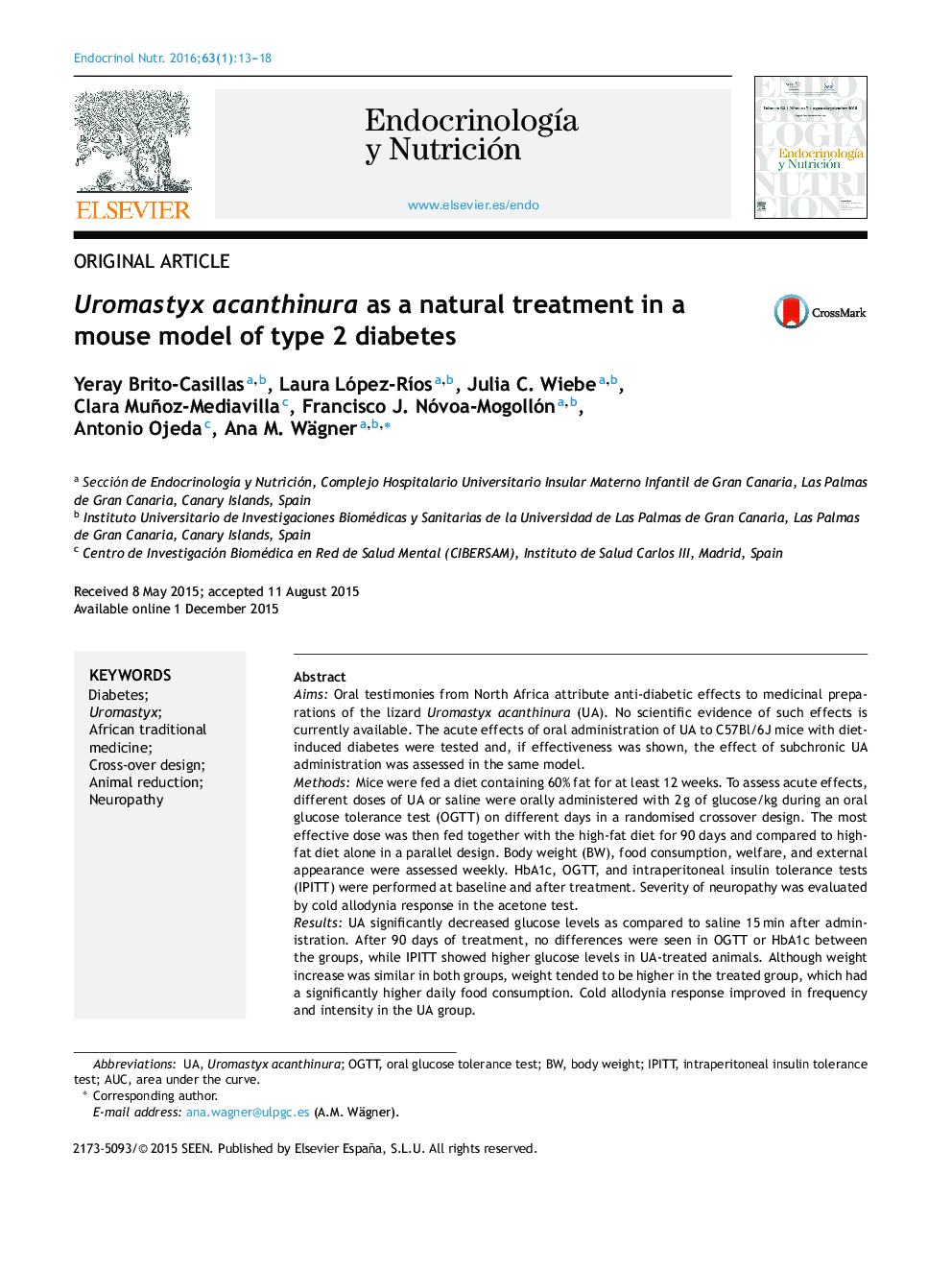| کد مقاله | کد نشریه | سال انتشار | مقاله انگلیسی | نسخه تمام متن |
|---|---|---|---|---|
| 3266973 | 1207957 | 2016 | 6 صفحه PDF | دانلود رایگان |
AimsOral testimonies from North Africa attribute anti-diabetic effects to medicinal preparations of the lizard Uromastyx acanthinura (UA). No scientific evidence of such effects is currently available. The acute effects of oral administration of UA to C57Bl/6J mice with diet-induced diabetes were tested and, if effectiveness was shown, the effect of subchronic UA administration was assessed in the same model.MethodsMice were fed a diet containing 60% fat for at least 12 weeks. To assess acute effects, different doses of UA or saline were orally administered with 2 g of glucose/kg during an oral glucose tolerance test (OGTT) on different days in a randomised crossover design. The most effective dose was then fed together with the high-fat diet for 90 days and compared to high-fat diet alone in a parallel design. Body weight (BW), food consumption, welfare, and external appearance were assessed weekly. HbA1c, OGTT, and intraperitoneal insulin tolerance tests (IPITT) were performed at baseline and after treatment. Severity of neuropathy was evaluated by cold allodynia response in the acetone test.ResultsUA significantly decreased glucose levels as compared to saline 15 min after administration. After 90 days of treatment, no differences were seen in OGTT or HbA1c between the groups, while IPITT showed higher glucose levels in UA-treated animals. Although weight increase was similar in both groups, weight tended to be higher in the treated group, which had a significantly higher daily food consumption. Cold allodynia response improved in frequency and intensity in the UA group.ConclusionsOrally administered UA acutely decreased blood glucose in diabetic mice. Paradoxically, long-term administration of UA increased food consumption, weight, and insulin resistance. Improved nociceptive response suggested an effect on pain and/or neuropathy. Although additional studies are needed to elucidate the properties and potential applications of UA, our results highlight the value of ethnomedical approaches to African traditional medicine as starting point to evaluate new bioactive components.
ResumenObjetivosTestimonios orales Norteafricanos atribuyen efectos hipoglucemiantes a preparados medicinales del lagarto Uromastyx acanthinura (UA), para los que no existen evidencias científicas actualmente. El objetivo de este trabajo fue el de investigar los efectos agudos de UA administrado oralmente en ratones diabéticos C57Bl/6J inducidos por dieta grasa, y si se demostrase su efectividad evaluar el efecto de su administración subcrónica en el mismo modelo animal.MétodosFue administrada una dieta a los animales con un contenido graso del 60% durante al menos 12 semanas. Para evaluar los efectos agudos diferentes dosis de UA o suero salino fueron administrados conjuntamente con 2 g/kg de glucosa durante sobrecargas orales de glucosa (SOG), en diferentes días, siguiendo un diseño cruzado aleatorizado. La dosis más efectiva en esta fase fue entonces administrada mezclada en la dieta durante 90 días y comparada con dieta solo en un diseño paralelo. El peso corporal y el consumo de alimento fueron evaluados semanalmente. HbA1c, SOG, y test de tolerancia intraperitoneal a la insulina (TTIPI) fueron realizados al inicio y tras el tratamiento. La gravedad de la neuropatía fue determinada mediante la evaluación de la alodinia al frío.ResultadosEl UA redujo significativamente las concentraciones de glucosa de manera aguda en comparación con el control a los 15 min tras su administración. Tras 90 días de tratamiento no se observaron diferencias en las SOG o HbA1c entre grupos, mientras que para los test de tolerancia intraperitoneal a la isulina valores más altos de glucosa fueron determinados en los animales tratados con UA. Aunque ambos grupos aumentaron su peso, este tendió a ser mayor en los tratados, que a su vez consumieron significativamente más comida por día. La respuesta a la alodinia al frío mejoró en frecuencia e intensidad en los tratados con UA.ConclusionesEl UA administrado oralmente redujo de manera aguda la glucosa en sangre en ratones con diabetes. Paradójicamente, su administración crónica aumentó el consumo de alimento, el peso y la resistencia a la insulina. La mejora en la respuesta nociceptiva sugiere un efecto en el dolor y/o la neuropatía. Aunque son necesarios más estudios para aclarar las propiedades y posibles aplicaciones de este producto, nuestros resultados subrayan el valor de los enfoques etnomédicos hacia la medicina tradicional africana como origen para la evaluación de nuevos compuestos bioactivos.
Journal: Endocrinología y Nutrición (English Edition) - Volume 63, Issue 1, January 2016, Pages 13–18
